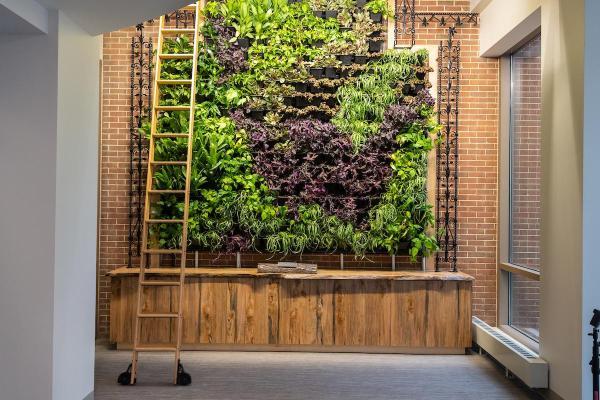Sustainability-Focused Living Green Wall Takes Root at UMSON

By Mary Therese Phelan
On any given day at the University of Maryland School of Nursing (UMSON), students can be found studying, collaborating, and, quite simply, just taking a breather in front of UMSON’s new living green wall, the two-story focal point of the Virginia Lee Franklin Lounge.
The living green wall was installed as part of the renovated, expanded footprint of the first and second floors of UMSON.
“We didn’t have a lot of student space where students could hang out, work in small groups together. And this has created that opportunity,” says Jane Kirschling, PhD, RN, FAAN, the Bill and Joanne Conway Dean.
Living green walls, composed of tightly packed, individually potted plants, improve indoor air quality and provide health benefits related to connecting to nature. The green wall system uses the plants’ soil medium to super filter the ambient air by pulling room air through the soil and returning it out for people to breathe. The air travels via clear plastic tubing along the edges of the green wall, and the pump required to circulate the air, along with the mechanisms associated with the self-watering system, are enclosed within the cabinet at the base of the green wall, made of repurposed wood.
UMSON’s green wall was inspired by one in the University of Maryland, Baltimore (UMB) Office of Design and Construction, after Anthony Consoli, AIA, LEED, AP, University architect, showed it to Kirschling. UMSON’s is now the only other living green wall on campus.
“When we were doing this project to expand the footprint at the School of Nursing, knowing that the School of Nursing so strongly believes in sustainability, it just seemed like a real natural fit to suggest it to them,” Consoli says. “Dean Kirschling immediately thought it was something she wanted to do as well.”
The wall is composed of 10 species of plants: platycerium bifurcatum (Staghorn Fern); peperomia clusiifolia (Pepermonia ‘Ginny’); tradescantia zebrina (Inch Plant); aglaonema ‘Silver Bay’ (Chinese Evergreen); dracaena trifasciata (Snakeplant); philodendron hederaceum ‘Brasil’ (Brasil Philodendron); hypoestes phyllostachya (Polka Dot Plant); cholorophytum comosum, (‘Bonnie’ Spiderplant); and philodendron hederaceum (Green Philodendron); and philodendron hederaceum ‘Lemon’ (Lemon Philodendron).
The wood at the green wall’s base was salvaged in part from a maple tree that had to be removed during construction of the building addition; the tree was originally donated by Susan Wozenski, JD, MPH, assistant professor and chair of the Department of Family and Community Health, in memory of her father, Joseph P. Wozenski.
Kirschling says she enjoyed telling Wozenski that a tree her father, a long-time advocate of nurses, had planted in the original UMSON courtyard would be featured at the base of the green wall.
“The other special moment is just to see it happen and see it come together,” she says, adding she recommends her fellow deans at UMB consider adding a living green wall to their buildings.
“We need to make our learning spaces, our workspaces, as appealing as possible, because we spend a lot of time here and we want to make sure that our employees, our students, have a sense of well-being and I do think green walls can do that,” Kirschling says.
The design also incorporates repurposed, salvaged metal from which UMB President Bruce Jarrell, MD, FACS, and his daughter, Gwynneth Jarrell, BSN ’06, RN, CPAN, a current Doctor of Nursing Practice student, both of whom are accomplished metalsmiths, created a decorative frame. The metal has its origins in Brooklyn, one of Baltimore’s southernmost neighborhoods. For the very top of the living green wall, the Jarrells created an element reminiscent of the Flossie, UMSON’s traditional nursing cap made of fluted lace (used until the end of the 1970s), from a curved ribbon of copper.
“We reached out to the president because the president does just such amazing metal work. And I said, ‘If we put a green wall in, we’re going to need some of your artistry,’” Kirschling says.
The green wall also fits with UMB’s and UMSON’s core value of sustainability and wellness, says Lorrie Voytek, BS, assistant director of development and chair of the School’s GreenSON Committee.
“The committee wants to promote a culture of a healthy working environment, and the green wall certainly adds to that culture,” she says. “Faculty, students, and staff will benefit from working and learning in a calmer, greener environment. And it helps to calm and reduce your blood pressure. It relieves pain. They have done all sorts of studies about how beneficial green walls are to be in interior spaces.”
In addition to improving air quality and bringing the outdoors indoors, the green wall has a lesser-known benefit.
“It actually absorbs sound,” Consoli says. “Compared to the brick wall that’s behind it, which would reflect sound, now the plants are actually absorbing sound comparatively.”
Unlike the green wall in the Office of Design and Construction, which is about 20 feet long and 5 feet high, the UMSON green wall is two stories tall, which proved challenging when it came to finding ways to maintain the plants, Consoli says. Kirschling had the solution: a library ladder.
Jarrell was thrilled the first time he saw the green wall – all 366 plants of it – completed.
“I think it’s magnificent. And I’m sure that student nurses will love being in here,” he says, noting there were two main reasons the project received not only his support, but also his participation. “First of all, it’s got to do with sustainability and having green products inside your buildings, which certainly must make it healthier. It certainly makes it more attractive, that’s for sure. But second of all, it’s just an opportunity to say that this isn’t just a campus of science, it’s also a campus of the environment, of important things to us as humans."